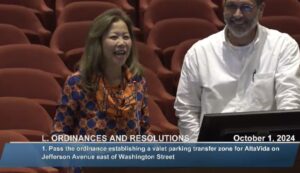The U.S. Environmental Protection Agency finished air monitoring around the now-closed Fisk and Crawford coal plants on Dec. 7, 2012.
Paul Ruesch, the on-scene coordinator for the EPA, said the agency should have the test results by the end of the month showing

whether dust is blowing from the sites into the surrounding community, as well as screening results for radiation levels surrounding the plants.
Heriberto Leon, the community involvement coordinator for the EPA, said the monitoring and screening are the result of concerns expressed by the Little Village Environmental Justice Organization and the Pilsen Environmental Rights and Reform Organization (PERRO.)
These concerns are part of an ongoing conflict between Midwest Generation, the owner of the sites, and local environmental groups over soil testing and remediation of the Fisk and Crawford plants.
Mayor Rahm Emanuel’s Fisk and Crawford Reuse Task Force and PERRO have both released reports describing how the Fisk and Crawford plants should be redeveloped. The Task Force released its report on Sept. 22, 2012, and PERRO released its report on Oct. 13, 2012.
Regarding remediation, the Task Force report stated, “sites will be remediated at the appropriate time, consistent with uses and requirements of applicable city laws and environmental regulations.”
The PERRO report urged more detailed language and transparency.
The report also advocated a two-phase remediation assessment. The first phase would be a “desktop study” outlining the history, geology, hydrology, and environmental risks of the site. The second phase would test the soil, culminating in a public report recommending steps for remediation.
“When PERRO did a process of community outreach over the summer with groups of the community, we had five different forums,” Jerry Mead-Lucero, a PERRO organizer and Task Force member, said. “Remediation was one of the main topics that was raised repeatedly in that people really wanted information.”
In August, Midwest Generation closed the Fisk and Crawford plants amid pressure from 17 environmental, health, and community organizations working under the banner of the Clean Power Coalition, the Task Force report stated.
The report also stated that after the closure of the plants, Emanuel created the Fisk and Crawford Reuse Task Force, choosing important members from the city government, Midwest Generation, and the Clean Power Coalition to create a report detailing how the sites should be redeveloped.
“PERRO, through the Task Force, has tried to have Phase I and II assessments completed and their results made public,” the PERRO report stated. “Midwest Generation has resisted the demand to have these assessments conducted and made public.”
Susan Olavarria, director of communications for Midwest Generation, said this shouldn’t be a problem because the sites are fully decommissioned, no hazardous materials are stored there, all unnecessary fuel and chemical products have been removed, and the Crawford coal pile is gone.
“The fact is, these are not hazardous sites,” she said. “Hundreds of workers have walked these sites for decades.”
Mead-Lucero is unconvinced. “Without the testing there’s no way to know that for sure,” he said. “That’s why testing the soil is the only way to be sure we know what we’re really dealing with on the site.”
Faith Bugel, a senior attorney for Chicago’s Environmental Law and Policy Center, said there’s not much Midwest Generation is obligated to do under law.
“What they were required to do was simply maintain and secure the sites after plant closure so it does not cause any hazard in the community,” she said. “It’s a ‘fence in the dog’ situation.”
Midwest Generation is only required to clean up contamination that is leaking off the site, Bugel said.
Ruesch said the EPA is testing is to see if there is anything to worry about to begin with. “I’m not measuring what’s in the dust—I’m just measuring if there’s dust,” He said. “If there’s a good amount of dust my risk assessment will tell me I need to characterize what’s in it, but I’m just taking it sort of step by step.”
Ruesch also said he’s skeptical that he will find anything after reading 2,500 pages of environmental assessments from 1998, 2011 and 2012 that Midwest Generation and Commonwealth Edison, its parent company, supplied the EPA.
“Based on historical information that’s been collected, I would say if they ever posed a health problem to the community it was when they were burning, but I can’t speak with certainty,” he said.
Olavarria says there is nothing out of the ordinary in how the remediation is being handled because the environmental remediation of industrial sites is often addressed in the sale and redevelopment process of the property.
“Nine times out of 10 if a company comes along and buys a plant like Fisk that company walks away with the liability for ground water, surface water, soil and contamination historically associated with the site,” Ruesch said.
Bugel said this is an example of where the law is behind the times. “What we’re really seeing across the country is the fact that a bunch of old plants built more than 100 years ago are shutting down,” she said. “The concern we now have is, oh boy, the law wasn’t really moving quick enough address the fact that when a huge piece of industry goes out of business there’s no burden on them to restore the property to the state it was in when they got it.” Bugel said the high cost of remediating an industrial site could make properties like the Fisk and Crawford sites unattractive to buyers.
“So within that reality there’s not a lot we can do,” Nelson Soza, executive director of the Pilsen Alliance and Task Force member, said. As a result, he says the Task Force is opting to focus on companies that will buy the sites and play an active role in the assessments and remediation of the plants. Olavarria said 25 potential buyers have expressed interest and visited the sites.
“The best thing that we thought we could do is promote the site and try to bring the right end user in so that whatever happens there ends up being as historical as the Fisk plant was,” Soza said.
Soza is optimistic that remediation and redevelopment will be a success. He said it is partially because of the political weight Emanuel has put into the future of the sites. This includes publicized events like a visit by New York Mayor Michael Bloomberg to tour Fisk and Crawford.
“It’s had a lot of publicity—everyone knows it exists,” Soza said. “So I think it would look really bad on the city and on the mayor in particular to have initiated a process that he would not finish.”
Soza’s optimism is also caused by what the Task Force does agree on.
“The report that the Task Force came out with talked a lot about the kind of commonalities that we all had about what we do want to see and don’t want to see, which is great news,” Mead-Lucero said.
Both the Task Force and PERRO reports say that redevelopment of the plants should bring living wage jobs to the area through light industry, as well as offer more green space and access to the river. This recommendation is based on surveys of neighborhood residents published by PERRO in its report that showed that 37 percent wanted more green space as the desired end use and 27 percent wanted living wage jobs.
Soza said he believes the redevelopment of these sites is a rare opportunity to improve the lives of Pilsen residents by helping remedy some of the neighborhood’s problems. According to census data, unemployment in Pilsen doubled between 2000 and 2010, and Soza said there is a notorious lack of green space.
“It will be our job to make sure that those who have been here and have suffered through the bad days can also enjoy some of the good days.”
Related articles























Be First to Comment